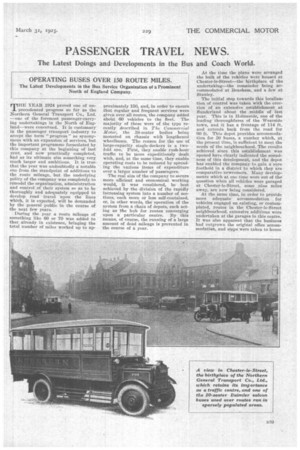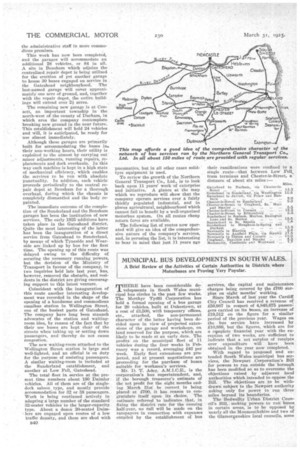PASSENGER TRAVEL NEWS.
Page 23

Page 24

If you've noticed an error in this article please click here to report it so we can fix it.
The Latest Doings and Developments in the Bus and Coach World.
OPERATING BUSES OVER 150 ROUTE MILES.
The Latest Developments in the Bus Service Organization of a Prominent North of England Company.
MHE YEAR 1924 proved one of un precedented progress so far as the Northern General Transport Co., Ltd. --one of the foremost passenger-carrying undertakings in the North of England—were concerned. It is customary in the passenger transport industry to accept the term " progress " as synonymous with an expansion of services, but the important programme formulated by this company at the beginning of last year, and now practically completed, had as its ultimate aim something very much larger and ambitious. It is true, that the year was undoubtedly a notable one from the standpoint of additions to the route mileage, but the underlying policy of the company was completely to remodel the organization, administration and control of their system so as to be thoroughly and adequately equipped to develop road travel upon the lines which, it is expected, will be demanded by the general public in the course of the next few years.
During the year a route mileage of something like 60 or 70 was added to that already in existence, bringing the total number of miles worked up to ap
proximately 150, and, in order to ensure that regular and frequent services were given over all routes, the company added about 60 vehicles to the fleet. The majority of these were of the type recently described in The Commereiad Motor, the 38-seater bodies being mounted on chassis with lengthened wheelbases. The reason for the use of large-capacity single-deckers is a twofold one. First, they enable rush-hour traffic to be more expeditiously dealt with, and, at the same time, they enable operating costs to be reduced by spreading the various items of expenditure over a larger number of passengers.
The real aim of the company to secure more efficient and economical working would, it was considered, be best achieved by the division of the rapidly increasing system into a number of sections, each more or less self-contained, or, in other words, the operation of the system from a chain of depots, each acting as the hub for routes converging upon a particular centre. By this means, of course, the running of a large amount of dead mileage is prevented in the course of a year.
At the time the plans were arranged the bulk of the vehicles were housed at Chester-le-Street—the birthplace of the undertaking—the remainder being accommodated at Bensham, and a few at Stanley.
The initial step towards this localization of control was taken with the erection of an extensive establishment at Sunderland about the middle of last year. This is in Holmeside, one of the leading thoroughfares of the Wearside town, and it has a frontage of 114 ft. and extends back from the road for 60 ft. This depot provides accommodation for SO buses, a number which, at the present time, is sufficient to meet the needs of the neighbourhood. The results achieved since this establishment was opened have clearly indicated the soundness of this development, and the depot has enabled the company to gain a sure foothold in a district to which they are comparative newcomers. Many developments which at one time were out of the question when all vehicles were garaged at Chester-le-Street, some nine miles away, are now being considered.
At the same time, in order to provide more adequate accommodation for vehicles engaged on existing, or contemplated, routes in the Chester-le-Street neighbourhood, extensive additions were undertaken at the garages in this centre. It was also apparent that the business had outgrown the original office accommodation, and steps were taken to house the administrative staff in more commodious premises.
This work has now been completed, and the garages will accommodate an additional 28 vehicles, or 84 in all. A site in Bensham which adjoins the centralized repair depot is being utilized for the erection of yet another garage to house 30 buses engaged on service in the Gateshead neighbourhood. The last-named garage will cover approximately one acre of ground, and, together with the repair depot, the entire buildings will extend over 21 acres.
The remaining new garage is at Consett, an important township in the north-west of the county of Durham, in which area the company contemplate breaking new ground in the near future. This establishment will hold 24 vehicles and will, it is anticipated, be ready for use almost immediately.
Although these garages are primarily built for accommodating the buses in.. their non-working hours, their utility is exploited to the utmost by carrying out minor adjustments, running repairs, replacements and dock overhauls. In this way each machine is kept in a high state of mechanical efficiency, which enables the services to be run with absolute punctuality. In addition, each vehicle proceeds periodically to the central repair depot at Bensham for a thorough overhapl, during which the chassis is completely dismantled and the body repainted.
The immediate outcome of the completion of the Sunderland and the Bensham garages has been the institution of new services. The early 1925 additions have taken place in the Gateshead district. Quite the most interesting of the latter has been the inauguration of a direct service from Gateshead to Sunderland, by means of which Tyneside and Wearside are linked up by bus for the first time. The opening up of this route was delayed owing to the difficulty of securing the necessary running powers, but the decision of the Ministry of Transport in favour of the company, in two inquiries held late last year, has, however, removed the obstacle, and residents in the district are giving encouraging support to this latest venture.
Coincident with the inauguration of this route another interesting development was recorded in the shape of the opening of a handsome and commodious omnibus station in Wellington Street, one of the busiest parts of Gateshead. The company have long been staunch advocates of the station and waitingroom idea, by reason of the fact that by their use buses are kept clear of the streets when taking up or setting down passengers, and thereby do not cause congestion.
The new waiting-room attached to the Wellington Street station is large and well-lighted, and an official is on duty for the purpose of assisting passengers. A similar waiting-room is included at the Sunderland establishment, and another at Low Fell, Gateshead.
The total fleet in service at the present time numbers about 180 Daimler vehicles. All of them are of the singledeck saloon type, and mostly provide accommodation for 32 or 38 passengers. Work is being continued actively in adapting a large number of the standard 32-seater vehicles to the larger-capacity type. About a dozen 20-seated Daimlers are engaged upon routes of a low traffic density, and these are shod with B40 pneumatics, but in all other cases solidtyre equipment is used.
To review the growth of the Ncrrthern General Transport Co., Ltd., is to look back upon 11 years' work of enterprise and initiative. A glance at the map which we reproduce will show that the company operate services over a fairly thickly populated industrial, and in places agricultural, neighbourhood which cannot fail to benefit by a well-organized motorbus system. On all routes cheap return fares are available.
Tile following list of routes now operated will give an idea of the comprehensive nature of the company's services, and, in perusing the list, it is interesting to bear in mind that just 11 years ago
their ramifications were confined to a single route—that between Low Fell., tram terminus and Chester-le-Street, a distance of about six miles:—
Gateshead to Durham, via Chester-leGateshead to Sunderland, via Washington 10.5 Gateshead to Jarrow, via Pelaw and Heb Chester-le-Street to Sunderland ... ... 9.0 Chester-le-Street to Craghead, So. Moor Chester-le-Street to Consett ... 12.3 CheAter-le-Street, to Edmondsley 5.3 Sunderland to Seaham, Murton, Easington Lane and So. Retten ... 125 Sunderland to So. Shields ... 7.4 Sunderland to Houghton-le-Spring and Newcastle to Blaydon 5.4 Newcastle to Anniteld Plain, via Stanley 17.5 Newcastle to DiptArn and Consett ... 15.0 Craghead, Tantobte and Stanley 4.5 Iledomtley, Castleside and Westwood 7.7




























